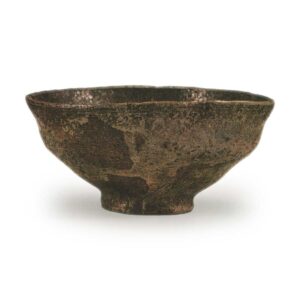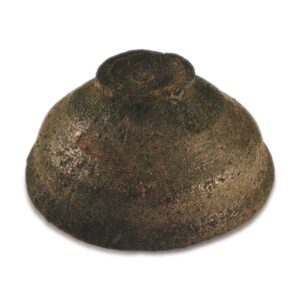

Height: 6.4-7.0cm
Diameter: 13.2-14.1cm
Foot diameter: 6.4cm
Height: 1.0cm
This is a famous bowl from the Kakinoobi (Persimmon Band) style, along with Bishamon-do and Otsu. It is said that it was owned by the Kyogoku family, and that is why it is called Kyogoku.
There are various shapes in the Kakinoobi style, and each bowl is slightly different. Generally, the Kakino-obi tea bowls are flat and low, but there are also slightly deeper bowls, such as the Tatsuta and Seo, and there are also bowls that give a somewhat vague impression, such as the Takigawa in the Nezu Museum and the Kakino-obi of the Hosokawa family. The tea bowls that are similar to the Kyogoku are the Otsu in the Fujita Museum in Osaka, which are similar in terms of their shape, glaze and rim. However, the Kyogoku tea bowl is slightly flatter and more compact.
I heard from an elderly person that the feel of the Kakinoobi tea bowl differs depending on the rim, and that among old tea masters, the Kakinoobi rim is divided into three types: Yamamichi, Toiguchi, and Bozuguchi. The name “yamamichi” comes from the flat edge of the rim, which looks like a narrow mountain path, like the one at Kyogoku. The name “toiguchi” comes from the flat rim, which looks a little sunken, like a gutter. The name “bozu-guchi” is said to come from the bowl’s round shape, which resembles a Buddhist monk’s head. However, the rim of the Kaki no Hana tea bowl is a naturally formed, unplanned shape, so it is difficult to clearly distinguish between these three types, and it may be a mistake to categorize them in this way.
In any case, the mouth of the Kyogoku tea bowl is flat at the top and has sharp corners, giving this tea bowl a sharp, incisive feel. The clay is a sandy clay with a slight iron content, and a thin layer of transparent white glaze has been applied to it. As it was poured using a ladle, there are parts of the outside that have not been covered in glaze, and these are commonly referred to as ‘fire marks’. This is the highlight of this teacup.
The firing process is called neutral flame, which is a reduction-type oxidizing flame firing, and the glaze color is complex, with various shades such as grayish brown, yellowish blue, and slightly reddish, as well as burnt areas of dark brown where the glaze does not cover. The foot ring is shaped like a helmet and has a whorl. There is also a whorl on the inside, but looking at the direction of the whorl, it is clear that the potter’s wheel rotated counterclockwise, unlike in Japan. There are no marks on the inside, but there are three clear marks on the foot ring, but the rest are not clear.
There is a crack running vertically down the side of the bowl, caused by the stone being bitten into, but this has become part of the bowl’s scenery.
The inner box is paulownia wood. The inscription is by Sakuma Shogen Shinkatsu, and the two characters “Kyogoku” are written on the back of the lid, on a gold-sprinkled paper, by Kobitsu Ryochu, who wrote “The two characters ‘Kyogoku’ are the real signature of Sakuma Shogen Shinkatsu, the tea bowl box lid front inscription. April 1886, Kobitsu Ryochu (seal)”
There is also a note attached to it that says “March 1886, Awaji-cho Sakai branch store, bid on at auction, high quality, January 1908, Toda Rogen, requested by Sato”, and it is said that it was originally passed down in the Kyogoku family, but in recent years it has returned to the Sano family in Nagoya, and it is included in the “Taisho Meiki Kan” (Famous Vessels of the Taisho Period).



